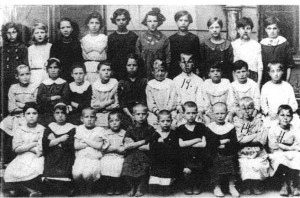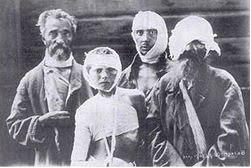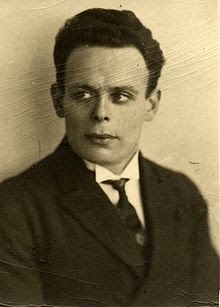Resources that focus on the condition of the Ukrainian Jewish population during and after World War I are sometimes hard to find. The reason for this is that they may be obscure references, be out-of-print or in another language other than English.
However, due to advances in technology and increasing efforts to digitize primary source material and put it online, there are a number of such resources available today. This era of time was subject to many pogroms which had been preceded by prior eras such as in approximately 1881 and 1905.
One of the primary resources relating to the pogroms which followed World War I is to be found as part of the Harvard University Library Open Collections Program, Aspiration, Acculturation, and Impact, Immigration to the United States, 1789-1930. The resource is entitled “Correspondence, 1915-1924, People’s Relief Committee for Jewish War Sufferers (U.S.)”, by Elias Heifitz (born 1885) and Israel Zangwill (1864-1926). The text is in Yiddish. It is found in online images and can be accessed by clicking here.
As described in the blurb about the resource on the site:
“The People’s Relief Committee for the Jewish War Sufferers (U.S.) was organized to aid Jewish victims of the Russian Civil War. Its work was co-ordinated with that of the American Jewish Relief Committee and the Central Relief Committee. Among its initiatives were fund raising for victim relief and the resettlement and adoption of orphaned Jewish children by Jewish families in the United States”.
Further, Elias Heifetz published a book in 1921 which further detailed the situation in the Ukraine which was entitled “The slaughter of the Jews in the Ukraine in 1919”. It can be found in Google Books by clicking here or on the Internet Archive site here. Heifetz was the Chairman of the All-Ukrainian Relief Committee for the Victims of Pogroms which was under the auspices of the Red Cross. The book contains information in the appendix of pogroms in Ovruch, Proskurov and Felshtin as well as many small villages. There are references for the shtetls such as Felshtin.
One such is a bibliography of references about the shtetl including information on the pogrom era – it can be accessed by clicking here. A well-known report on the pogroms was written by Israel Cohen, Special Commissioner of the Zionist Organization entitled “The Pogroms in Poland” which was published in 1919. In this report, there is mentioned the Jewish self-defense groups which were formed at the behest of the following:
- Jewish Military Committee – Moritz Freudlich, Captain, Engineer; Tobias Wechsler, Captain; Joseph Schonberg, Captain.
- Jewish National Council – Dr. Osias Thon, Dr. Henryk Schreiber, Dr. Josef Margulies.
- Polish Liquidation Committee – Count Lasocki, Chairman of Administrative Committee; Wladimir Tetmayer, Chairman of the Military Committee.
The Jewish Military Committee raised about 1,000 men, but these Jewish groups were disbanded and disarmed by General Boleslaw Roja, who was later said to be responsible for the worst pogrom in Lemberg (Lviv). One hundred and thirty towns were hit by pogroms during November-December, 1918, and January, 1919, and this report lists them, the pogrom date and what transpired.
An example is for the town of Brzesko, November 12-14, 1919:
Assaults, looting and murder by armed peasants from village of Jadowniki, who brought with them carts to remove plunder. The District commandant tried to intervene, but was rendered powerless by mob. Detachment of 30 Jewish Militiamen from Cracow disarmed by Polish legionaries, who took active part in pogrom. Several houses set on fire; fugitives were shot at. 8 Jews killed (including two soldiers and one man thrown under passing train) and 8 seriously injured. 376 Jews robbed; estimated damage 20 million crowns (about £800,000 pre-war rate).
Another example is for the town of Lemberg (Lviv), November 22-23, 1919, and December 29-30, 1919:
The most savage and destructive pogrom. A punitive expedition by Polish troops, aided by rabble, against the Jews because of their neutrality in Polish-Ukrainian war. Assaults, robbery, outrage, murder, arson. 73 Jews killed, a few hundred seriously injured; 49 houses and synagogues completely burned to ground. Estimated damage 100 million kronen (over £4,000,000).
The pogrom was also covered in the November 30, 1918 edition of the New York Times (available by clicking here) whose headline stated “1,100 Jews Murdered in Lemberg Pogroms, Hundreds Burned to Death in a Synagogue or Shot in Flight – 600 Houses Burned”. This was according to dispatches in the Berlin newspapers transmitted by the Copenhagen correspondent of the Central News. In addition, The Jewish Chronicle in London on December 6, 1918, repeated similar and more detailed occurrences in Lemberg (Lviv) based on further reliable reportage by correspondants such as Max Reiner who was on the scene.
Other newspaper references to the pogroms are to be found on many digital sites including one in Australia, Trove, which is associated with the National Library of Australia (available by clicking here).
The Jewish Chronicle online archive has numerous articles and appeals regarding the pogroms. One has only to put in the word pogrom and the year and find what one wants. An interesting aspect of the pogroms was seen in the January 23, 1920 issue.
There is a short piece which states that the female victims of the pogroms were subject to conversion tactics of missionaries. To avoid this activity, Jewish officials tried to setup homes for these women who were presently housed in Catholic institutions. Also mentioned in several other articles was the fact that women were abducted by the Cossacks. As to whether they survived their abduction and stayed to live in the Cossack community is another story.
Another resource was published in Yiddish by YIVO in 1965 which was written by Elias Tcherikower. He was a co-founder of YIVO and went to Kiev, Ukraine, to gather evidence of the pogroms in the Ukraine.
His book is entitled: “Di ukrainer pogromen in yor 1919 (The Pogroms in the Ukraine in 1919)”. Extracts of this book were translated into English and can be found by clicking here. In addition, YIVO has a special Elias Tcherikower Collection, accessible by clicking here, which has many primary documentary resources for the Ukrainian pogroms. It is well-worth visiting YIVO to review these resources.
One other well-known Jewish archivist of the pogroms was Nahum Gergel who wrote “The Pogroms in the Ukraine in 1918-1921, which was published in English by YIVO in 1951 in their YIVO Annual of Jewish Social Science.
A resource for pogroms in general and with specific chapter for the Ukrainian pogroms is the book edited by John D. Klier and Shlomo Lambroza entitled “Pogroms, Anti-Jewish violence in modern Russian history” and is accessbile by clicking here.
There is also a comprehensive online bibliography of resources on the pogroms by Jonathan D. Smele which is entitled “The Russian Revolution and Civil War, 1917-1921: an annotated bibliography” (available here). It enables the researcher to locate the references mentioned on Google Books or other online portals.
There are even resources for films which were made at the time of the pogroms and an interesting portal for this is Filmography Home of Israeli Film site, which has a section entitled “Documentary films recording the Pogroms in the Ukraine”. The site describes two of the short films available. Another reference to a film is found in The Jewish Chronicle archives, July 30, 1920 edition, which has an advert for “The Land of Mystery”. Evidently, the film, a melodrama, was made in Russia and had real scenes of pogroms according to the advert. It also covered Lithuania and, in particular, Kaunas. It was produced by an American, Harold Shaw, and the script was written by Basil Thomson, the head of the British Directorate of Intelligence. At the time it was thought to have been the most expensive British film made. More about the film can be gleaned by clicking here.
In addition, Tony Shaw has written about the film in “Early warnings of the Red Peril: A pre-history of Cold War British cinema, 1917-1939” in “Film History”, Vol. 14, No. 3/4 War and Militarism (2002), pp. 354-368, Indiana University Press. First-hand accounts are also now online such as the one to be found on by clicking here. It tells the story of the remarkable escape from the Ukraine to Canada by the Dezick (Dayson) and Nemetz families and their relatives.
Much, much more is available online, an inexhaustible supply of references, which are growing daily as things are being digitized for public consumption. All it takes is looking into the Internet with either a general topic or specific shtetl in mind.



Interesting article. I am trying to find information about a pogrom or other attack on the Jews of Bar, Podolya, Ukraine 1923-25. Any help would be appreciated